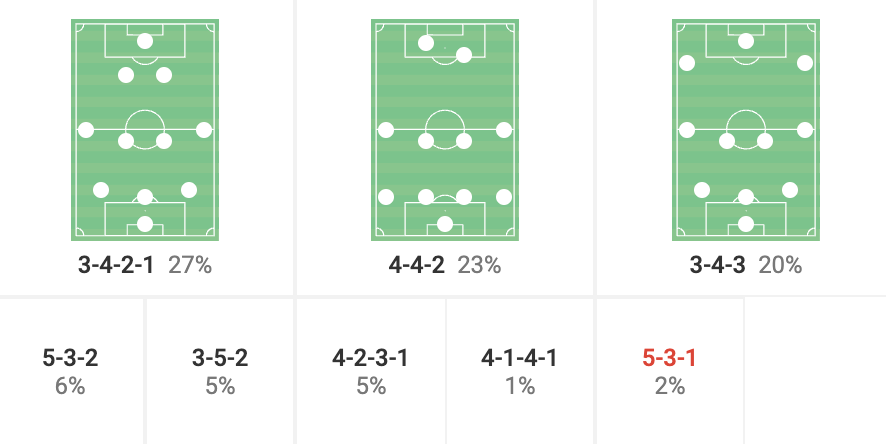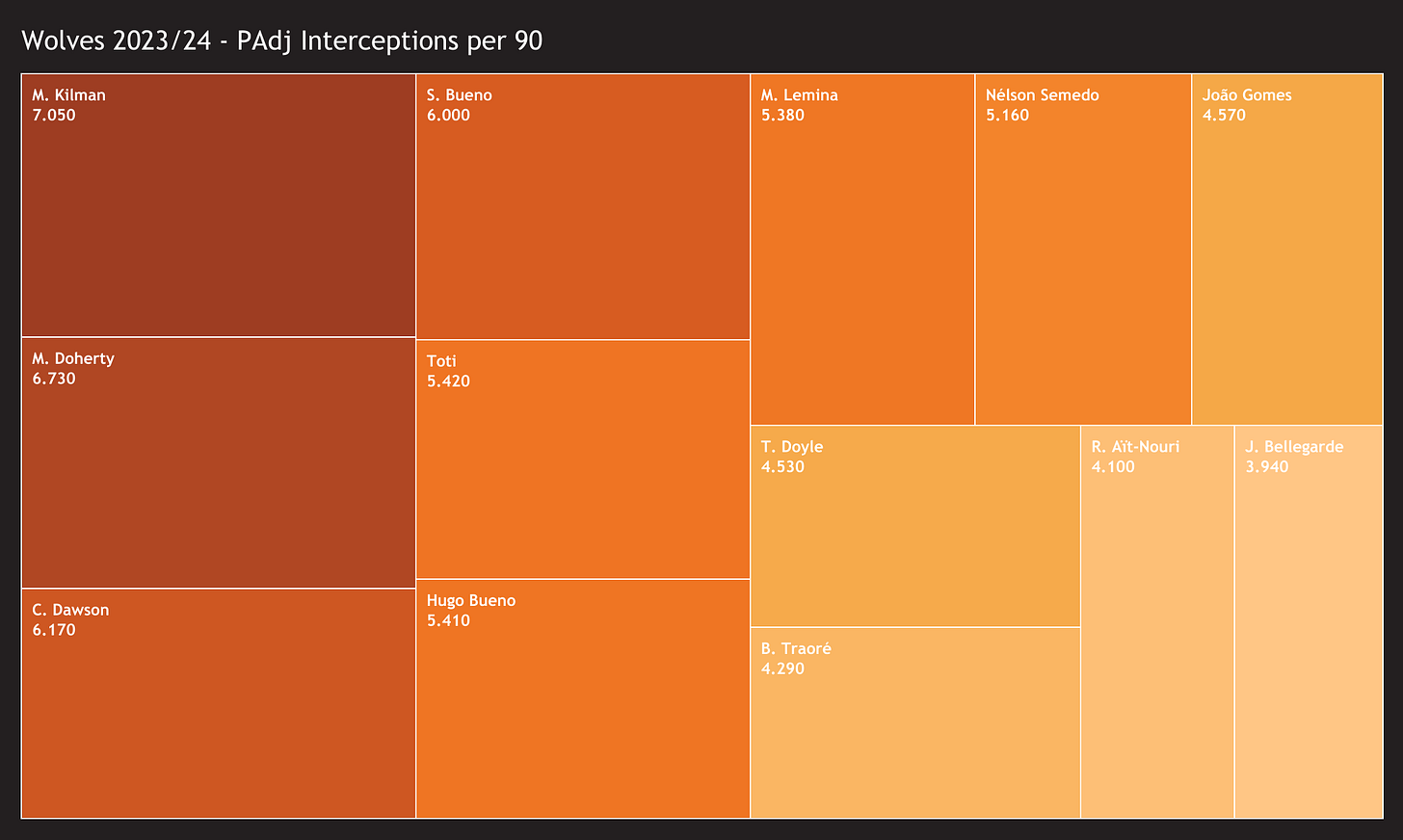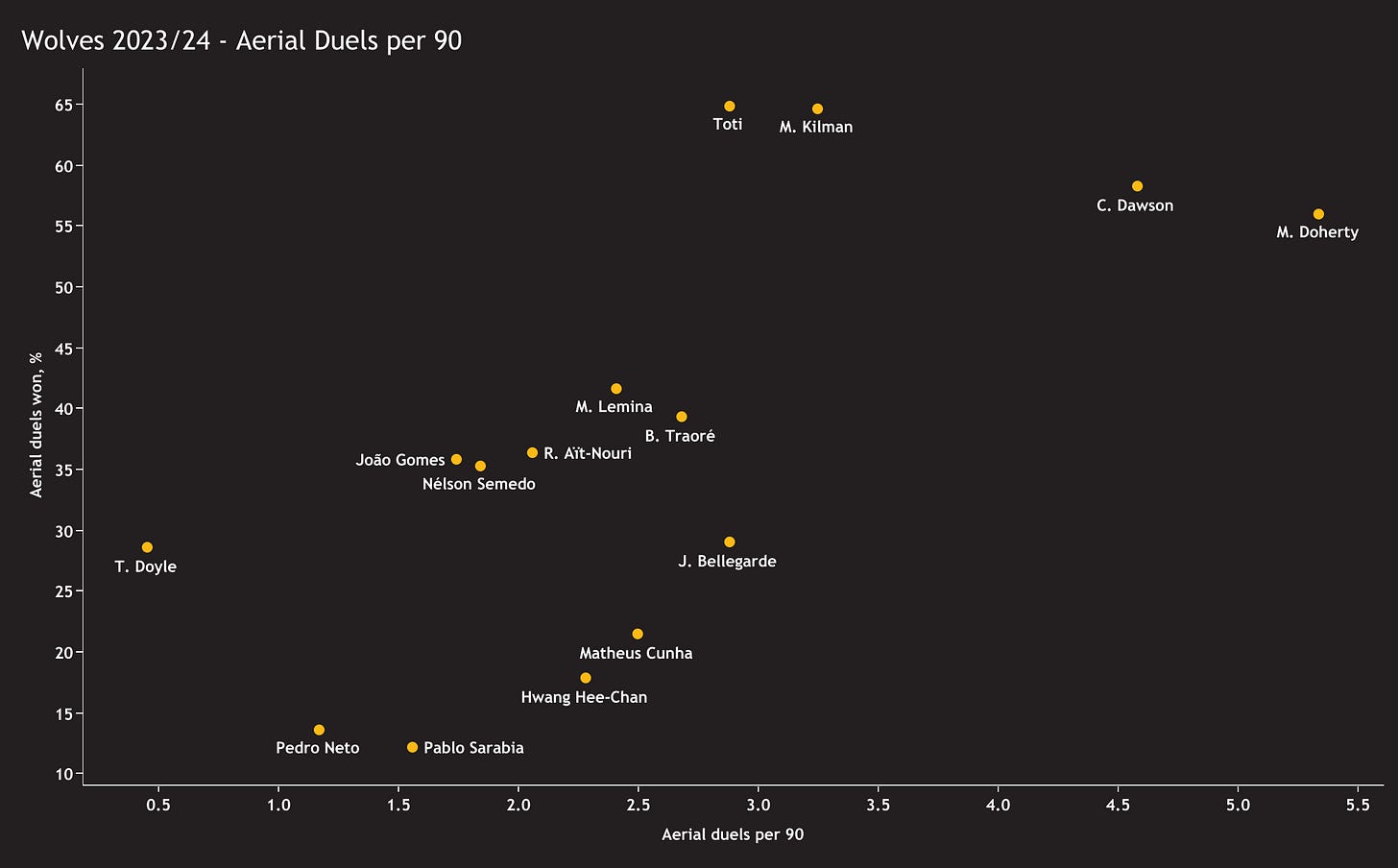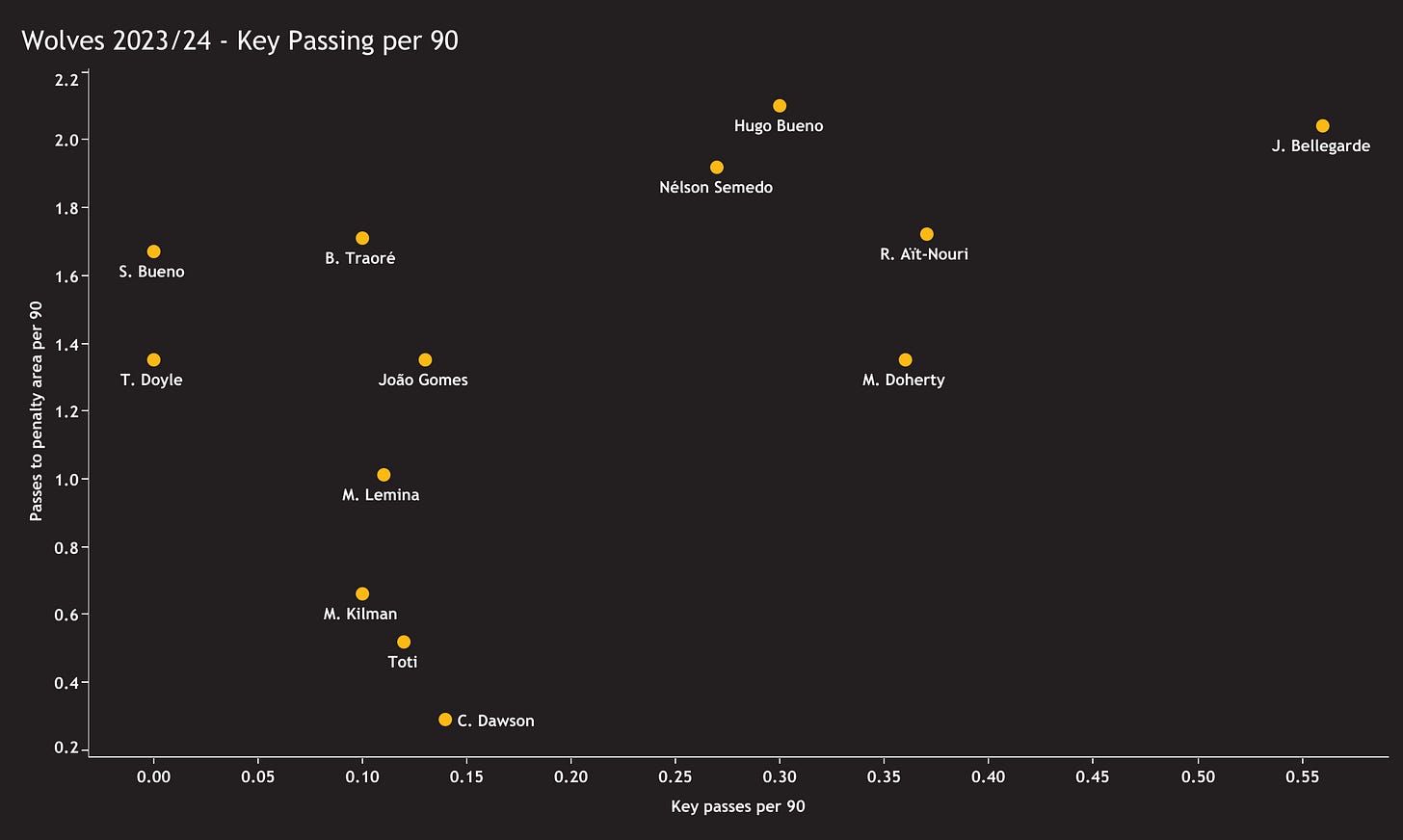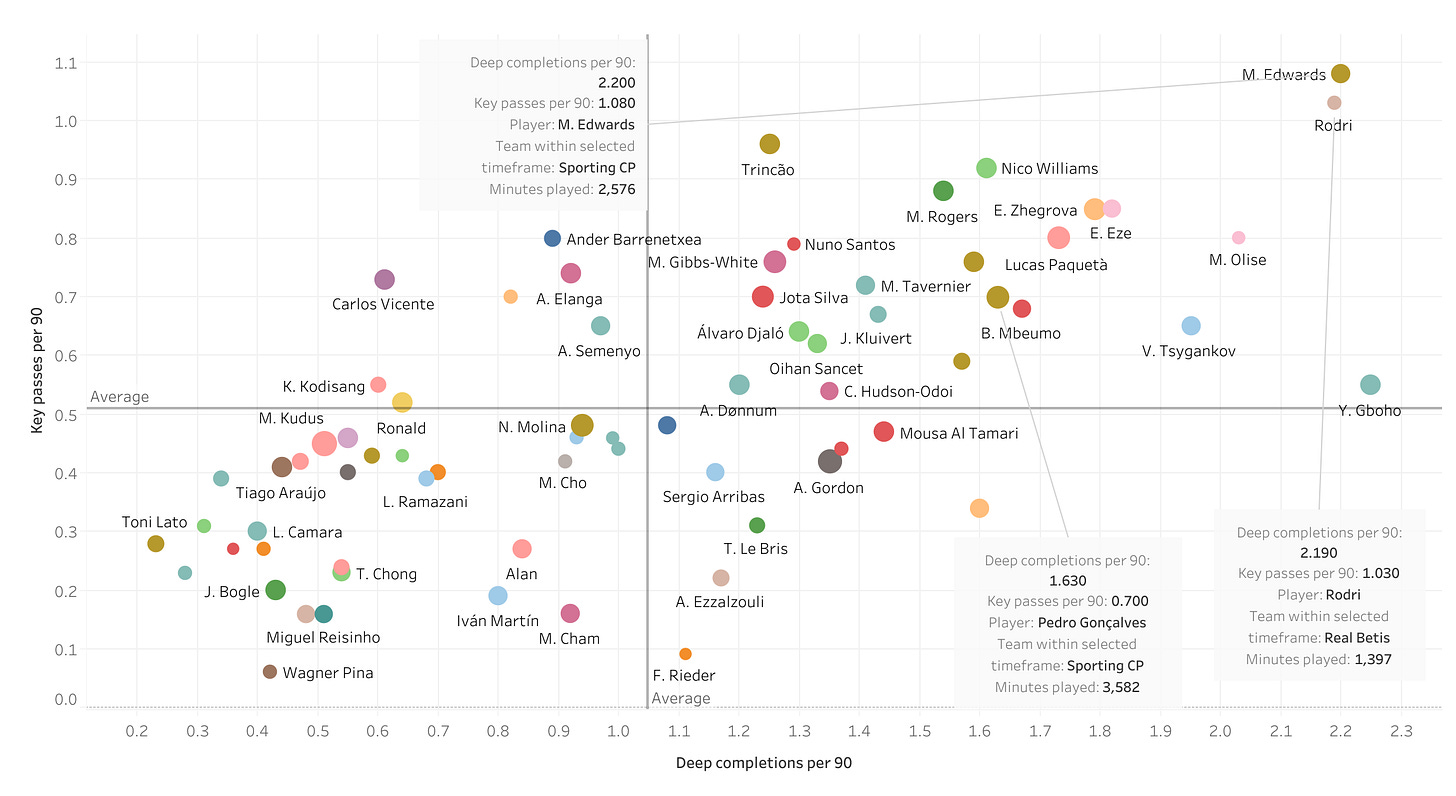Building a recruitment plan: Wolves
Creating a framework for recruitment based on previous seasons.
Subscribe for weekly content, scout reports, tactical analyses and opinion pieces.
What is a recruitment plan?
A recruitment plan or strategy is essentially the approach that a football club adopts to acquire new players and manage player movements within the team. It involves identifying the team's needs, scouting potential talent, negotiating transfers, and ensuring that new signings complement the existing squad and playing style.
Transfer strategies are crucial for several reasons. Firstly, they enable clubs to strengthen their squads and address any weaknesses or gaps in their team. By identifying areas that need improvement clubs can target players who possess the desired skills and attributes to enhance the team's performance.
Moreover, this can help clubs manage their resources effectively. In today's competitive football landscape, financial management is essential, and clubs must ensure they are making smart investments in player recruitment. A well-thought-out transfer strategy considers budget constraints, player valuation, and potential resale value, allowing clubs to make informed decisions and avoid overspending.
Additionally, transfer strategies play a crucial role in long-term planning and squad building. Clubs must not only focus on immediate needs but also consider the team's future and development over time. By identifying and nurturing young talent, as well as balancing experienced players with emerging prospects, clubs can maintain a sustainable and competitive squad for years to come.
Finally, any actions in the transfer market will affect team cohesion and chemistry. Bringing in new players can disrupt the dynamics within the squad, and it is essential to ensure that new signings integrate seamlessly into the team. Clubs must consider factors such as personality, playing style, and team culture when recruiting players, as this can affect the overall harmony and performance of the team on the pitch.
Squad building in the Premier League
The graph above shows us the net spend of all 20 Premier League clubs this season and the number of points per game they accrued. We can see that only four clubs have made a net profit this season, Wolves being one of them. In terms of points per game, Gary O’Neil’s side averaged 1.28 points per game which sees them in 12th place in the table, pretty much where we would expect given their ppg.
Unsurprisingly, Chelsea has had the biggest net spend closely followed by Arsenal, Spurs, Manchester City and United. In the case of Arsenal, City and Liverpool we can see that they average the highest number of points per game. This suggests that although they have spent big money, they have recruited the right players and are reaping the rewards in terms of notching up the points.
So, in order to develop any sort of recruitment policy we need to consider the main markets that Wolves target.

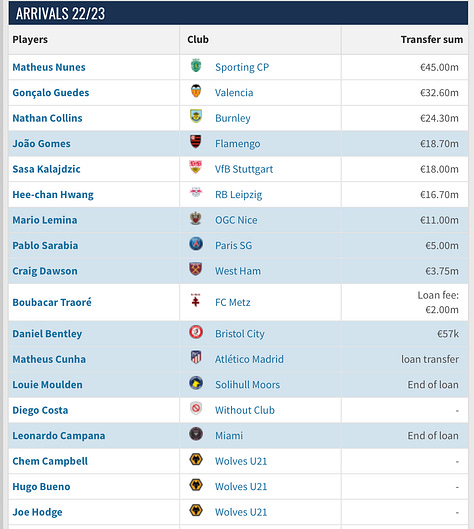

Thanks to Transfermarkt, we can assess the players that have arrived at Molineux over the last three seasons. The graphic above tells us that Wolves primarily turn to La Liga (Cunha, Bueno, Guedes), Ligue 1 (Bellegarde, Traoré, Sarabia, Lemina, Aït-Nouri) and the Primeira Liga (Nunes, Chiquinho) and of course we will look at potential candidates within the Premier League.
Furthermore, the most Wolves have spent on a player over the last three seasons is the €50 million to bring in Matheus Cunha. Therefore, we will filter out any players above this price tag when considering our options.
The next aspect we must consider is the tactical set-up Gary O’Neil employs.
The graphic shows us that O’Neil mostly sends his team out in a 3-4-2-1 system, a 4-4-2 or a 3-4-3. We can see that O’Neil is flexible in his tactical approach, fluctuating between a back three or a back four depending on the opponent.
Regardless of the opposition or the tactical setup, in the attacking phase, Wolves look to be direct and utilise rapid transitions to their advantage. They average 49.42% possession this season which is in keeping with O’Neil’s approach and how he wants his team to attack at speed rather than dominating possession.
Interestingly Wolves have taken the third lowest number of shots this season, 411 with only Burnley and Sheffield United having fewer. This translates to 10.89 shots per 90 and according to Wyscout, 39.5% of them hit the target.
Hwang Hee-Chan and Matheus Cunha lead the goal-scoring charts with 12 league goals apiece while the latter has also racked up 8 assists. Pedro Neto leads the assists tally with nine though.
As we would expect given the tactical preferred setup, Wolves typically look to attack down the flanks, utilising their wingbacks and forwards for ball progression. The priority is on getting the ball upfield quickly by any means necessary.
Defensively, Wolves look to remain compact and limit the opposition’s ability to play through their structure hence why midfielders who can act as 6/8 hybrids are very important to O’Neil’s tactics.
Now, let’s turn our attention to the current squad:
The average age of this squad is 25.7 years, which is reflected in the graphic above. We can see that 34-year-old Craig Dawson is the oldest player in the squad. So this is a team that doesn’t require an overhaul, instead, it’s about adding one or two players to allow Wolves to move to the next level potentially.
Data Sample:
20-26 years old
Over 1000 minutes played
La Liga, Ligue 1, Premier League and Primeira Liga
Under €60 million in value (according to Wyscout)
Ignore any unrealistic signings still left in the data sample
Defensive Actions
The first position we are going to look at is central defence. To do this, we first need to gain an understanding of the overall efficiency of the existing Wolves’ defence.
The first metric we are going to look at is possession-adjusted interceptions. Unsurprisingly, it is the defensive unit that performs best in this metric, with Max Kilman executing 7.05 PAdj interceptions per 90. Matt Doherty and Craig Dawson are the second and third-best performers with 6.73 and 6.17 PAdj interceptions respectively.
Next, we will look at sliding tackles. As we can see from the data viz here, midfielder João Gomes averages 1.65 PAdj sliding tackles per 90, the most in the team. Left-back/left-wing back Rayan Aït-Nouri averages 1.05 per 90 while Mario Lemina averages 0.69.
João Gomes leads the charts in terms of defensive duels per 90, averaging 11.02 and winning 62.99% of them. Tommy Doyle participates in fewer duels but wins over 69% of them, giving him the best defensive duel win rate at the club.
Defenders, Craig Dawson, Max Kilman and Toti execute the fewest defensive duels out of the defensive unit.
Looking at aerial duels, we can see that the best performers here are the defenders, as we would expect. Toti has the highest win percentage of 64.89%, however, he does execute fewer than three of his teammates.
Max Kilman executes 3.25 aerial duels per 90 and has a win percentage of 64.66% while Craig Dawson chips in with 4.58 aerial duels per 90 and a win percentage of 58.28%.
Now, we can look at potential transfer targets from our sample group. This first chart has combined PAdj interceptions and PAdj sliding tackles to showcase the players’ overall defensive efficiency.
Four players stand out here, first Reims 6ft 4in central defender Joseph Okumu. The 26-year-old averages 8.41 possession-adjusted interceptions and 0.84 possession-adjusted sliding tackles. Next, we can see there are two Premier League players out of our four standouts. Chris Mepham of Bournemouth averages 7.460 interceptions and 1 sliding tackle while Luton’s Gabriel Osho has performed well in a team which has struggled this season, averaging 7.21 PAdj interceptions and 0.67 PAdj sliding tackles per 90.
Finally, we return to Ligue 1 for Marseille’s 25-year-old Argentinian central defender, Leonardo Balerdi. The former Borussia Dortmund man averages 6.55 PAdj interceptions and 0.66 PAdj sliding tackles per 90 and has played the most amount of football out of our selected four players.
Next, let’s see how our four highlighted players perform in terms of defensive duels. Balerdi performs very well in these metrics, averaging 8.29 defensive duels per 90 and winning 74.62% of them. His fellow Ligue 1 compatriot Okumu, averages 6.53 defensive duels per 90 and wins 69.74% of them.
Meanwhile, Osho averages 9.05 defensive duels per 90 with a win rate of 72.12% then we have Mepham who averages 8.07 and 66.17% respectively.
Looking at aerial duels we can see that Balerdi is the weakest performer as he averages 3.71 aerial duels per 90 and wins 54.73% of them, however, these numbers would still place him well above average compared to the current Wolves squad.
Okumu averages 3.74 aerial duels per 90 with a win rate of 62.07%. Mepham averages the highest number of aerial duels out of our chosen four with 5.95 per 90 and he wins 59.18% of them. Finally, Osho’s numbers are 4 duels per 90 and a win percentage of 58.7%.
Top Target: Leonardo Balerdi
Ball Progression
Next, we turn our attention towards ball progression. The data visual above shows us how the Wolves players perform in terms of progressive passes per 90 and progressive runs per 90.
Midfielder Tommy Doyle averages the most progressive passes with 7.47 per 90. He is closely followed by Toti and Nélson Semedo who average 7.35 and 7.05 per 90. Meanwhile, Pedro Neto leads the progressive run charts, averaging 4.69 per 90 followed by Matheus Cunha with 3.46 per 90.
João Gomes and Mario Lemina average 4.01 and 3.59 progressive passes per 90 suggesting there is not much ball progression via the midfielders. Perhaps this is an area that would benefit from a little more of a creative spark to create more goal-scoring opportunities, as we mentioned earlier, Wolves have taken the third lowest number of shots this season with only Sheffield United and Burnley taking fewer.
In terms of dribbles per 90, Neto is streets ahead of any of his teammates, averaging 7.31 per 90 with a success percentage of 49.64% indicating he is the primary ball-carrier regarding moving Wolves up the pitch. The next best performers are Bellegard who averages 5.11 dribbles per 90 with a 61.82% success rate and Cunha who averages 5.10 dribbles per 90 and has a 50.30% success rate.
Here, we can analyse Wolves’ key passing (which is a pass leading to a shot). We can clearly see that Bellegard is the best performer by some distance in this metric. He averages 0.56 key passes per 90 and 2.04 passes into the penalty area.
Hugo Bueno and Nélson Semedo perform well in terms of passes into the penalty area with 2.1 and 1.92 per 90. However, there is reason to say that Wolves are lacking that figure who can progress the ball centrally which is something we will look to address next.
Central Progression
So, we need a player who can act as a hybrid 6/8 and sit in when O’Neil wants his side to remain compact but can also contribute to the attacking phase when Wolves are on the front foot. Here are four players who could potentially provide the team with a boost regarding central ball progression.
First, Enzo Le Fée, the 24-year-old Rennes midfielder averages 7.56 progressive passes per 90 and 2.38 progressive runs per 90. Staying in Ligue 1, the next player on the list is Lyon’s Maxence Caqueret who is more experienced than Le Fée at playing in a deeper role. He averages 8.19 progressive passes per 90 and 1.78 progressive runs per 90.
Next, moving to Portugal, a market Wolves know very well, we have Braga’s Spanish midfielder Rodrigo Zalazar. The 24-year-old averages 7.35 progressive passes per 90 and 2.04 progressive runs per 90.
Our final player is Gustavo Hamer of Sheffield United. The former Coventry man has been the standout player in a poor team and is reportedly available for £15 million which makes him a very appealing option for a mid-table Premier League side. Hamer averages 6.08 progressive passes per 90 and 1.21 progressive runs per 90.
This data viz shows us the passes into the penalty area and key passes per 90 for our sample. Le Fée averages 0.63 key passes per 90 and 3.09 into the penalty area whilst his fellow Frenchman, Caqueret, averages 0.41 key passes per 90 and 2.67 passes into the opposition area.
Rodrigo Zalazar averages 0.83 key passes per 90 for Braga and 3.06 passes to the penalty area. Finally, Hamer averages 0.65 key passes per 90 and 2.31 passes to the opposition area in the worst team in the Premier League this season indicating he still manages to have a creative presence despite his teammates being unable to find the back of the net.
Top Target: Maxence Caqueret / Gustavo Hamer
Wide Progression
Pedro Neto. Will he stay or will he go? It’s difficult to answer this question but as we saw above, Neto is basically the primary attacking outlet who carries Wolves forward so if they were to lose him, it would be a huge loss for the team. So, let’s look at the data sample for a potential replacement.
Firstly, looking at the progressive actions of the players, three stood out - two from the same team one of which brings something a little different to the table. So the first player is Real Betis’ Rodri who averages 6.64 progressive passes per 90 and 3.35 progressive runs per 90.
Next, we head to Portugal and two players at Sporting. The first one is Marcus Edwards who averages 4.23 progressive passes per 90 and 4.16 progressive runs per 90. The third player on this list is Pedro Gonçalves who as we can see, is not the typical ball carrier akin to Pedro Neto, he is more of a passer which would provide Wolves with a different attacking outlet rather than looking to individuals to progress the play. He averages 5.2 progressive passes per 90 and 1.76 progressive runs per 90 and can play out wide or centrally offering even more options to Gary O’Neil.
Next, looking at dribbles per 90 we can see the Rodri averages 5.99 dribbles per 90 with a success rating of 62.37%. Edwards averages 8.28 dribbles per 90 but is slightly below average with a success rate of 49.79%.
Pedro Gonçalves averages 3.74 dribbles per 90 and has the lowest success rate of the three with 47.65%.
Turning our attention to the creativity of these players, we will be looking at key passes as before but this time, we will pair it with the metric of deep completions per 90 as this is more pertinent to the role. (Wyscout states that a deep completion is: a non-cross pass that is targeted to the zone within 20 meters of the opponent’s goal).
We can see that Rodri averages 1.03 key passes per 90 and 2.19 deep completions per 90. Edwards averages 1.08 key passes per 90 and 2.2 deep completions while his teammate, Gonçalves averages 0.7 key passes and 1.63 deep completions per 90.
Top Target: Marcus Edwards
Goal Output
Finally, we are going to look at the players who can put the ball in the back of the net.
Here, we can see that Cunha and Hwang are the two primary goalscorers for Wolves and that there is then quite a gap between them and the rest of the team concerning goal output. Of course, as they are forwards, this is normal but there is a distinct lack of goals in this side especially if one or both of them get injured.
Hwang averages 0.49 goals per 90 from an xG of 0.38 per 90 while Cunha averages 0.39 goals per 90 from an xG of 0.31 per 90.
When looking at shots on target, we can see that Cunha averages 2.25 shots per 90 and half of them are on target (50.79%).
Sarabia averages 2.03 shots per 90 with 37.21% finding the target while Pedro Neto averages 1.87 shots per 90 with 34.29% being on target.
Finally, Hwang averages 1.58 shots per 90 and 43.59% are classed as being on target.
Based on what we saw above, we will now delve into the data sample to find a goalscorer. Firstly, we have a player who would probably cost a premium as he is Brazilian and is a proven goalscorer in Evanilson. The 24-year-old has netted over 50 goals for Porto and gained plenty of experience. The data shows that he averages 0.73 goals per 90 from an xG of 0.52 per 90 indicating he can take lower percentage opportunities.
Next, we have Sevilla’s Isaac Romero who averages 0.56 goals per 90 from an xG of 0.47 per 90. The 23-year-old is a slightly riskier option as he has only just broken into the first team this season. Remaining in La Liga, our next option is Girona’s Ukrainian forward, Artem Dovbyk, who averages 0.64 goals per 90 from an xG of 0.64 per 90.
Finally, we head to the South of France where we find Toulouse’s Dutch forward, Thijs Dallinga who averages 0.45 goals per 90 from an xG of 0.55 per 90. A slight underperformance but he is still well above average compared to the data sample.
Here, we can see shots per 90 vs shots on target %. Porto’s Evanilson averages 2.57 shots per 90 with 48.24% being on target while Isaac Romero averages 2.99 shots per 90 with 49.43% being on target.
Dovbyk averages 2.28 shots per 90 with 54.88% finding the target and Thijs Dallinga averages 2.65 shots per 90 with 44.34% hitting the target. Again, a little below average but still better than the majority of the Wolves shots per 90 and shots on target % (with the exception of Cunha).
Based on this, Evanilson would be an exceptional signing but would cost a premium and has expressed no desire to leave Porto. Thijs Dallinga represents a good signing who could be available for slightly less and still bring some added firepower to the front line.
Top Target: Evanilson / Thijs Dallinga
Conclusion
In this piece, we have analysed data and created a blueprint based on Wolves’ previous activity in the transfer market and Gary O’Neil’s tactical style. It will be interesting to see how the window plays out and which players the club opt to bring in as they look to strengthen ahead of the new season, of course, this will be O’Neils first preseason allowing him to begin to build the squad in the shape he sees fit.
Inspired by:







